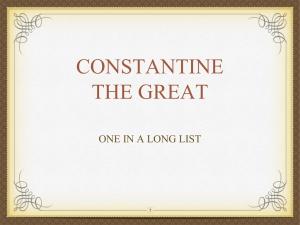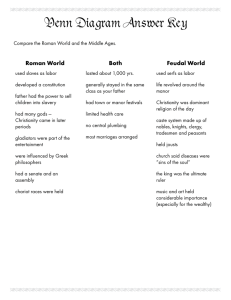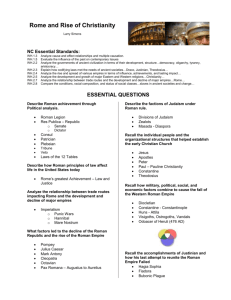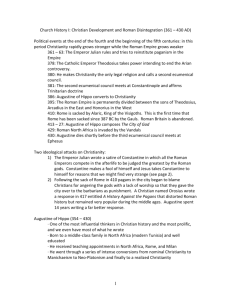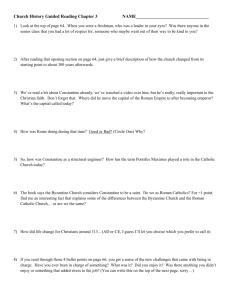How Did Christianity Become the Dominant
advertisement
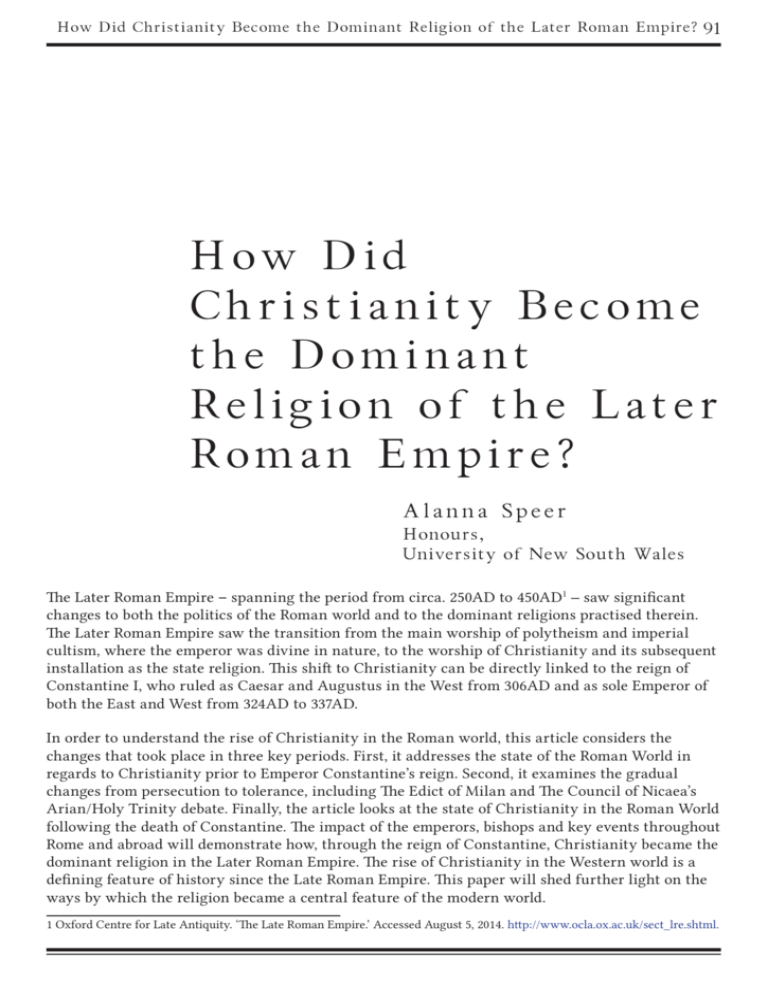
How Did Christianity Become the Dominant Religion of the Later Roman Empire? 91 How Did Christianity Become the Dominant Religion of the Later Roman Empire? Alanna Speer Honours, University of New South Wales The Later Roman Empire – spanning the period from circa. 250AD to 450AD1 – saw significant changes to both the politics of the Roman world and to the dominant religions practised therein. The Later Roman Empire saw the transition from the main worship of polytheism and imperial cultism, where the emperor was divine in nature, to the worship of Christianity and its subsequent installation as the state religion. This shift to Christianity can be directly linked to the reign of Constantine I, who ruled as Caesar and Augustus in the West from 306AD and as sole Emperor of both the East and West from 324AD to 337AD. In order to understand the rise of Christianity in the Roman world, this article considers the changes that took place in three key periods. First, it addresses the state of the Roman World in regards to Christianity prior to Emperor Constantine’s reign. Second, it examines the gradual changes from persecution to tolerance, including The Edict of Milan and The Council of Nicaea’s Arian/Holy Trinity debate. Finally, the article looks at the state of Christianity in the Roman World following the death of Constantine. The impact of the emperors, bishops and key events throughout Rome and abroad will demonstrate how, through the reign of Constantine, Christianity became the dominant religion in the Later Roman Empire. The rise of Christianity in the Western world is a defining feature of history since the Late Roman Empire. This paper will shed further light on the ways by which the religion became a central feature of the modern world. 1 Oxford Centre for Late Antiquity. ‘The Late Roman Empire.’ Accessed August 5, 2014. http://www.ocla.ox.ac.uk/sect_lre.shtml. 92 history in the making vol. 3 no. 2 Prior to its installation as the state religion, Christianity and Christians faced ongoing persecution. Christianity had been one of the numerous growing religious sects in Rome since the death of Christ, but Christians were persecuted under the reign of Nero in 64AD, following the great fire of Rome. As Tacitus notes, Nero blamed Christians for the fire, writing: But all human efforts, all the lavish gifts of the emperor, and the propitiations of the gods, did not banish the sinister belief that the conflagration was the result of an order. Consequently, to get rid of the report, Nero fastened the guilt and inflicted the most exquisite tortures on a class hated for their abominations, called Christians by the populace.2 The persecution of Christians continued after Nero into the reigns of Trajan, Hadrian and Decius, the latter being responsible for an edict in 250AD which required all citizens to hold a sacrifice for the emperor in front of an imperial official who would issue them a libellous, an official document which certified that they had performed the sacrifice. The edict forced Christians to choose between forsaking their religion or the threat of death, and was one of earliest examples of an emperor exercising central control over the worship of the state religion for non-celebratory reasons.3 While the persecution of Christians was prevalent throughout this period, it is important to acknowledge that this edict of Decius in 250AD may not have been issued as a direct attack on Christians, but rather as an attempt towards a single politic. Candida Moss suggests that the edict was ‘about political uniformity, not religious persecution’.4 In 303AD, the tetrarchy5 of Diocletian, Maximian, Galerius, and Constantius – the latter being Constantine I’s father –began issuing edicts which sought to remove and hinder the growth of Christianity in the Empire. Commonly known as The Great Persecution, these edicts initially saw the destruction of churches, limiting the opportunity for Christian assemblies and eventually focusing on removing the Christian bishops and hierarchies.6 Eventually, in 304AD, an edict similar to Decius’ was issued by Emperor Diocletian where once again all citizens were required to perform a collective sacrifice. This may support Moss’ distinction that Decius was to some extent unintentionally persecuting Christians with his edicts, as the Tetrarchy’s edict of 304AD seems much more intentional in their desire to see Christians singled out and persecuted. Following the death of his father, Constantius in 306AD, Constantine became Caesar of the West, ruling alongside the tetrarchy of Licinius, Maximinus and Galerius. I would classify the following twenty years from Constantine’s election to Cesar and his eventual role as sole emperor in 324AD as a time of civil wars and changes to the role of Christianity. Crucial to this change in the perception and status of Christianity was the Edict of Toleration, submitted by Galerius in 311AD. This edict sought to effectively end The Great Persecution of Diocletian. It is interesting to note that Galerius himself was a part of The Great Persecution. This apparent ‘change of heart’ in regards to Christians could be understood as Galerius simply wishing that his successor not have to deal 2 Tacitus, Annals, XV:44. 3 Stephen Mitchell, A History of the Later Roman Empire, AD 284-641, (Malden, MA: Blackwell Publications, 2007), 240. 4 Candida R. Moss, The Myth of Persecution, (New York: Harper One, 2013), 15. 5 The tetrarchy is a form of government where four individuals rule as the leaders. The tetrarchy was often split between two Caesars and two Augusti. The more senior position, the Augusti, held more power and responsibility. 6 Christopher S. Mackay, Ancient Rome, (Cambridge: Cambridge University Press, 2004), 301. How Did Christianity Become the Dominant Religion of the Later Roman Empire? 93 with the difficulty of maintaining the persecution, which Mackay suggests was a failure and an unneeded stress on the ruling emperors.7 Lactantius details keys points from the Edict of Toleration: the publication of our edict, ordaining the Christians to betake themselves to the observance of the ancient institutions, many of them were subdued through the fear of danger, and moreover many of them were exposed to jeopardy; nevertheless, because great numbers still persist in their opinions… we, from our wonted clemency in bestowing pardon on all, have judged it fit to extend our indulgence to those men, and to permit them again to be Christians, and to establish the places of their religious assemblies… and that they themselves may live securely in their habitations.8 Following the death of Galerius, the tetrarchy consisted of Constantine, Licinius, Maximinus and Maxentius. However, Jacob Burckhardt suggests that this tetrarchy did not follow the same system as that of Diocletian, in that each of these men considered themselves Augustus of their own region and were distrustful of one another.9 Licinius and Constantine joined together as uneasy allies on account of being brothers in law; this union was matched by the Maximinus and Maxentius forming an allegiance. The civil wars were fought both in the west, with Constantine fighting Maxentius, and in the East, with Licinius fighting Maximinus. The Battle of the Milvian Bridge in 312AD is often represented as the beginning of Constantine’s sole rule and his apparent conversion to Christianity.10 It is detailed by ancient writers that before the battle, Constantine received a vision from God detailing that a show of devotion from the ruler would result in a victorious battle. Eusebius accounts for Constantine’s victory as a result of divine intervention: two God-beloved emperors, honoured alike for their intelligence and their piety, — being stirred up against the two most impious tyrants by God, the absolute Ruler and Saviour of all, engaged in formal war against them, with God as their ally, Maxentius was defeated at Rome by Constantine in a remarkable manner, and the tyrant of the East did not long survive him.11 Following the disposition of Maxentius in 312AD and Maximinus in 313AD, Constantine and Licinius ruled the Empire together. However, this did not last long, as in 314AD the two Emperors were once again involved in a civil war against one another. Over the next ten years an uneasy truce was maintained between the two; that is, until 324AD, when Licinius was eventually defeated by Constantine and exiled. Constantine was now the sole ruler of the Roman Empire. The Edict of Toleration and Constantine’s ‘divine’ victories over his enemies begin to suggest a reason as to the increasing dominance of Christianity in the Later Roman Empire. Before the civil war between Constantine and Licinius, the Edict of Milan was created in 313AD by the two emperors, effectively introducing Christianity as a legitimate and recognised religion. Widely and sometimes falsely believed to be the introduction of Christianity as the dominant state religion, the Edict of Milan primarily but not exclusively addressed the role of Christians in the 7 Ibid., 305. 8 Lactantius, Of The Manner In Which The Persecutors Died, XXXIV. 9 Jacob Burckhardt, The Age of Constantine the Great, (New York: Pantheon Books, 1949), 258. 10 H. A. Drake, ‘The Impact of Constantine on Christianity,’ in The Cambridge Companion to the Age of Constantine, ed. Noel Emmanuel Lenski, rev. ed. (Cambridge: Cambridge University Press, 2012), 113. 11 Eusebius, The Church History, IX:I. 94 history in the making vol. 3 no. 2 Roman Empire and the change from the tolerant stance of the state to their benevolent inclination towards Christianity. The edict served as a declaration of a citizen’s freedom of religion. It acted as a protection for all free citizens as Christianity was now accepted by the Roman state. Drake highlights how the two emperors did not make any distinction as to which religion was ‘correct’; rather they appeared to have learned from their predecessors’ mistakes. He notes that although Constantine was openly Christian, ‘he would not return to the policy of coercion, whose disastrous consequences were apparent to all’.12 The Edict of Milan saw sanctions which allowed Christians to practise their religion, form assemblies, regain stolen possessions and live without fear of persecution. Lactantius’ account of the Edict of Milan highlights its difference from the Edict of Toleration. The conclusion to the Edict of Milan stated that: you [the Christians] are to use your utmost diligence, to the end that our orders be speedily obeyed, and our gracious purpose in securing the public tranquillity promoted.’13 In contrast to the Edict of Toleration, the Edict of Milan sought to instil a feeling of ‘tranquillity’ within the empire rather than simply tolerating the Christians in order to ensure the stability and security of the state from conflicts. The Edict of Milan can be considered as the major turning point from simple tolerance of Christians to actual benevolence, highlighting Christianity’s rising dominance in the Later Roman Empire. In 325AD, twelve years after the Edict of Milan was issued, the first Council of Nicaea took place. It was held by Constantine to discuss and decide upon various key elements of Christian theology. Michael Maas addresses the key concerns and conflicts surrounding the discussion of theology at this time, noting: Disagreement about the relation of the divinity in Christ to the divinity of the Father proved exceptionally divisive in the Late Antique church. Defining the Trinity and explaining the unity as well as the distinctiveness of its elements preoccupied churchmen and provided the intellectual foundations of sectarian divisions among Christian communities.14 The council took place in Nicaea, a location well suited as it was easily accessible by both Eastern and Western bishops and, importantly, very close to Constantine’s residence in his newly renamed city of Constantinople, formally Byzantium.15 The most important discussion undertaken at the council of Nicaea was the Arian and Trinitarian debate. The belief of the Arians and the leader Arius was that God and Christ the son were two different entities – the first being divine and the latter being not divine – and were not one and the same. Arius summarises his beliefs in a letter to Pope Alexander of Alexandria: 12 Drake, ‘The Impact of Constantine on Christianity’, 122. 13 Lactantius, Of the Manner in Which the Persecutors Died, XLVIII. 14 Michael Maas, Readings in Late Antiquity: A Sourcebook, 2nd ed. (London: Routledge, 2010), 131. 15 Øyvind Norderval, ‘The Emperor Constantine and Arius: Unity in the Church and Unity in the Empire,’ Studia Theologica – Nordic Journal of Theology, Vol. 42, No. 1, (1988), 123. How Did Christianity Become the Dominant Religion of the Later Roman Empire? 95 Our faith, from our ancestors, which we have learned also from you, is this. We know one God — alone unbegotten, alone everlasting, alone without beginning, alone true, alone possessing immortality, alone wise, alone good, alone master, judge of all, manager, director, immutable and unchangeable, just and good… But he begot him [Jesus Christ] not in appearance but in truth, having submitted him to his own will, an immutable and unchangeable perfect creature of God.16 Conversely, Alexander believed in the Trinitarian theology, which stated that God, Jesus Christ and the Holy Spirit were at once a single entity and three separate beings. This disagreement led to Constantine initially ordering the two to come to terms and cease their debate; however, failing any resolution of the conflict, the Council of Nicaea was called. Many historical writers were present and even more have written about the Council, including Sozomen, Socrates of Constantinople, Theodoret, Eusebius of Caesarea, Eusebius of Nicomedia and Athanasius of Alexandria. The debate between the Arians and the Trinity eventually ended in favour of the Trinity theology. Sozomen describes the actions of Constantine following this decision: To this judgment the emperor likewise deferred, for he regarded the unanimity of the conference to be a divine approbation; and he ordained that anyone who should be rebellious thereto, should forthwith be sent into banishment, as guilty of endeavouring to overthrow the Divine definitions.17 While the debate between the Arians and the Trinitarians was undoubtedly a major cause of the need for the council and the main focal point, other theological issues were raised and decided at this event. These issues included the dating of Easter, which was eventually agreed upon as ‘the first Sunday after the fool moon that falls on or after March 21’ – also known as the Spring Equinox in the Northern Hemisphere – amongst all Christian bishops and theologists.18 Peter Brown suggests that the council was a way for Constantine to ensure uniformity amongst Christendom – whether this was out of piety and devotion or a more political desire is unknown and often debated amongst modern historians – and that his successful council contrasted heavily with the pervious state of the Roman World where the varied and ‘colourful’ polytheistic worship ruled.19 The Council of Nicaea demonstrates the significant shift to Christianity from the polytheistic worship that was superior only fifty years prior. It demonstrates the extremity of the rise of Christianity as even respected patrons such as Arius faced exile for his opposition. In order to fully address how Christianity became the dominant religion of the Later Roman Empire, it is important to highlight its functioning after the death of Constantine I in 337AD. A brief civil war erupted between his three sons, Constans, Constantius II, and Constantine II, who he had legitimised, divided regions for and set to continue in a dynastic rule following his death.20 Following the rise of Constantius II as the sole Emperor, various changes and challenges to Nicene Christianity became apparent. Perhaps the most significant was the fact that Constantine I’s own son and new emperor, Constantius II, was widely considered to be Arian and therefore sought to 16 Arius, Letter to Alexander of Alexandria, 2. 17 Sozomen, The Ecclesiastical History, I:XX. 18 Laurence Hull Stookey, Calendar: Christ’s Time for the Church, (Nashville, TN: Abingdon Press, 1996). 19 Peter Brown, The Rise of Western Christendom, (Malden, MA: Blackwell Publishers, 2003), 61. 20 Burckhardt, The Age of Constantine the Great, 274. 96 history in the making vol. 3 no. 2 see Nicene Christianity deposed for the Arian equivalent.21 Even more worrying for the survival of Christianity following Constantine was the inclination of Constantius II successor, Julian, to the old Roman worship of the polytheism. Ammianus Marcellinus accounts for the Christian bishops, Dracontius and Georgius, being kidnapped and murdered by ‘pagans’ and Emperor Julian’s subsequent response: The emperor, on hearing of this abominable deed, was bent upon taking vengeance, but just as he was on the point of inflicting the extreme penalty upon the guilty parties, he was pacified by his intimates, who counselled leniency.22 Eventually in 380AD, under the rule of Valentinian II, Gratian and Theodosius I, Nicene Christianity was reinstated and maintained as the Official Roman Religion in their Cunctos Populous or Edict of Thessalonica. Outlined in the Theodosian Codex, the Edict of Thessalonica saw the reinstalment of Nicene Christianity and the new persecution of ‘pagans’: It is our desire that all the various nations which are subject to our Clemency and Moderation, should continue in the profession of that religion which was delivered to the Romans by the divine Apostle Peter… According to the apostolic teaching and the doctrine of the Gospel, let us believe the one deity of the Father, the Son and the Holy Spirit, in equally majesty and in a holy Trinity… but as for the others, since, in our judgement, they are foolish madmen, we decree that they shall be branded with the ignominious name of heretics, and shall not presume to give to their conventicles the name of churches.23 The reformation of Nicene Christianity and persecution of Polytheism highlights a complete shift from the state of the Empire prior to the reign of Constantine I. The Edict of Thessalonica is in almost direct disagreement with the Edict of Toleration of 311AD and even more so in disagreement with the Edict of Milan of 313AD. The grandson of Theodosius I, Valentinian III, represented one of the last instances where the state controlled the religion. Valentinian III’s edict saw the primacy of the Pope become dominant. He ‘handed over’ the control, responsibilities and leadership of Roman Christianity to the Bishop of Rome, Pope Leo I, as he believed – most likely under the strong influence of Leo – that ‘no-one may presume to act without permission of this see [The Apostolic See], since the peace of the Church can be maintained only when the whole church recognises its ruler’.24 Although experiencing a short period of change to Nicene Christianity following the death of Constantine I, the various Edicts and actions of the members of the Theodosian Dynasty saw the permanent arrangement of Nicene Christianity as the Official Roman religion, now fully emphasising the dominance of Christianity in the Later Roman Empire. From being persecuted as a small religious sect to the strongest and dominant religion in The Later Roman Empire, Christianity evolved greatly over the 400 year period from 50AD-450AD. The initial persecution under polytheistic emperors such as Nero and the edicts of Decius and Diocletian demonstrate the state of Christianity before its acceptance in Roman Society. The ecumenical councils such as the Council of Nicaea in 325AD, held by bishops and the Emperor of Rome, 21 William G. Rusch, The Trinitarian Controversy, ( Philadelphia: Fortress Press, 1980), 21. 22 Ammianus Marcellinus, The Roman History, XX:XI.XI. 23 Codex Theodosian, XVI:i.2. 24 Henry Bettenson and Chris Maunder, Documents of the Christian Church, 4th ed. (New York: Oxford University Press, 2011), 24. How Did Christianity Become the Dominant Religion of the Later Roman Empire? 97 Constantine, saw Christianity not only being accepted as a legitimate religion but also its adoption as the official state religion. In doing so, they replaced the worship of polytheism and imperial cultism and created and maintained a theistic institution that would continue for another 1500 years. Understanding the rise of Christianity is crucial for making sense of the broader histories of the Western world in the modern era. As this article has argued, Christianity’s turbulent rise, linked to the reign of Constantine I, is a far more complex narrative than that typically presented in the study of the Roman and wider world.
